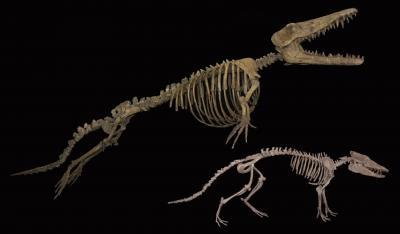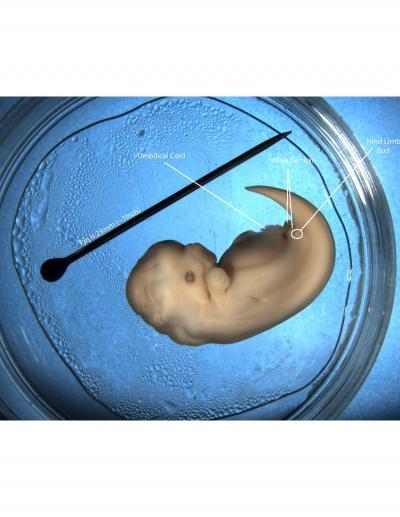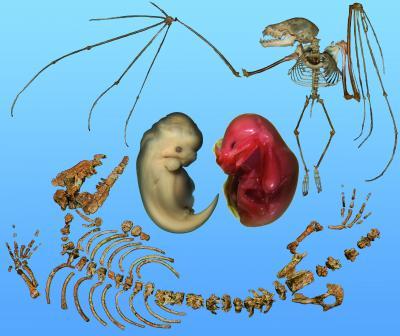Paleontology, with its rocks and fossils, seems far removed from the world of developmental genetics, with its petri dishes and embryos. Whereas paleontology strives to determine "What happened in evolution?", developmental genetics uses gene control in embryos to try to answer "How did it happen?" Combined, the two approaches can lead to remarkable insights that benefit both fields.
In the current issue of the Journal of Vertebrate Paleontology, Hans Thewissen, Ingalls-Brown Professor at Northeast Ohio Medical University (NEOMED), and his colleagues review recent studies that have used modern genetic techniques to shed light on fossils, and vice versa. "It is a very exciting time to be an evolutionary scientist. So many researchers are investigating evolution, either by finding new fossils or by figuring out the genes that underlie changes in evolution. Now it is possible to combine those two fields and go beyond what each field could have accomplished on its own," said Dr. Thewissen.

Figure 1 - Mounted skeletons of the extinct whales Ambulocetus and Pakicetus, both found in Pakistan, respectively 48 and 49 million years old.
(Photo Credit: Thewissen-Lab, NEOMED)
Their review discusses the profound evolutionary changes that brought about some of the more spectacular animals of today and the past, including dolphins, whales, snakes, bats, elephants, and dinosaurs. For instance, although the transition from a four-legged ancestor to something with only two forelimbs, like a dolphin, or no limbs at all, like a snake, may seem like a big leap, transitional fossils have been discovered that bridge these gaps. Additionally, using developmental genetics, researchers have come to understand that these large changes in shape involved relatively small changes in the working of just of few genes.
Perhaps even more fascinating, recent research has discovered that similarly shaped organisms may not have experienced similar developmental changes in their past. Cetaceans (whales and dolphins) and snakes both lost limbs independently from their respective ancestors through evolution, but they did so in different ways. Snakes lost their forelimbs by basically getting rid of their neck region and leaving no room for forelimbs. During snake embryonic development, no limb buds form in that region of the body. Snakes do still develop hind limb buds as embryos, but the genes that control their growth have been knocked out through the course of evolution, so hind limbs do not develop (except for small stubs in some snakes like pythons). This demonstrates that different developmental mechanisms can be at work even in the evolutionary history of a single animal. Whales and dolphins lost their hind limbs in a process similar to that of snakes.

Figure 2 - The embryo of the pantropical spotted dolphin Stenella attenuata in the fifth week of development. The hind limbs are present as small bumps (hind limb buds) near the base of the tail. The pin is approximately 1 inch long.
(Photo Credit: Thewissen-Lab, NEOMED)
Dr. Thewissen says, "For me personally, as someone who has spent most of his life studying fossil whales, it is very exciting to be able to use information from the development of living mammals, and use it to teach me about how whale evolution happened, 50 million years ago."
Scientists can even modify the genetic code of living animals to replicate changes that have been observed in the fossil record. As explained in the paper, it has been shown that heightened activity of a particular gene in mouse embryos causes their teeth to grow larger. A similar change occurred during the course of elephant evolution -- early elephants had teeth less than an inch long, while modern elephants have teeth over a foot in length. The genetic changes that brought about this increase in size in elephants may have resembled the ones induced in lab mice.
This sort of cross-pollination of biological disciplines was once rare but is increasingly common. The paper was co-authored with Lisa Noelle Cooper, also of NEOMED, and Richard R. Behringer of the Department of Genetics at the University of Texas MD Anderson Cancer Center. Dr. Cooper said, "At a time when most of science is hyper-specialized, my hope is that the newest generations of scientists are able and unafraid to approach research questions using a variety of techniques."

Figure 3 -- A bat and dolphin embryo illustrate the process of forelimb enlargement and hind limb reduction, respectively, in the orders Chiroptera and Cetacea. The fossil record shows that Eocene whales (Ambulocetus natans) still had hind limbs, but the earliest known bats looked much like modern Carollia perspicilata.
(Photo Credit: T. Hieronymus, K. Sears)